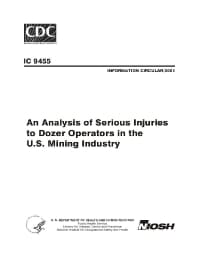Mining Publication: An Analysis of Serious Injuries to Dozer Operators in the U.S. Mining Industry
Original creation date: April 2001
Authors: WJ Wiehagen, AG Mayton, JS Jaspal, FC Turin
NIOSHTIC2 Number: 20001030
U.S. Department of Health and Human Services, Public Health Service, Centers for Disease Control and Prevention, National Institute for Occupational Safety and Health, DHHS (NIOSH) Publication No. 2001-126, Information Circular 9455, 2001 Apr :1-23
This report describes serious injuries occurring to bulldozer operators working at U.S. coal, metal, and nonmetal mines. The period covered is 1988-97. The data were collected by the Mine Safety and Health Administration (MSHA). A total of 873 injury records are examined. These injuries resulted in 18 fatalities and 31,866 lost workdays. All of these injuries occurred to dozer operators while they were doing common production tasks. An injury classification system was developed to code the narrative information that describes the circumstances surrounding the injuries. Injury records are categorized by activity (task being done), incident result (what apparently happened to the dozer), and operator impact (how the operator was injured). Where information is available, contributing factors are identified. This classification system supplemented the standard injury/illness data classification system compiled by MSHA. The results of the study indicate that, from 1993 to 1997, the number of serious injuries to dozer operators declined by 30%. The reduction in serious injuries was accompanied by a decrease in days lost due to injury. Although the number of reported injuries has decreased, dozer operators being jolted and jarred accounts for the largest percentage (70% of the incidents) and severity (75% of the workdays lost) of serious injuries while operating the equipment. Vertical jars (while backing up the dozer) resulting in injury to the operator accounted for a sizable percentage of jolting and jarring injuries. Working near an edge carries significant risk for fatal injuries. Of 116 incidents where the dozer fell over an edge, rolled over, or fell into a hidden void, 14 (12% resulted in fatal injuries. In cases where the dozer operator either jumped or was thrown out of the cab in a fallover or rollover, 7 out of 26 were killed. Overall, 80% of the fatalities occurred while working near an edge or hidden void or on a steep slope. Further reductions in injury risk will require more widespread use of seat belts, field and laboratory research interventions to better assess the effect of alternative engineering (e.g., seat and seat suspension) designs to dampen or isolate the effects of shock and vibration, and continued focus on hazard awareness, recognition, and response.

NIOSHTIC2 Number: 20001030
U.S. Department of Health and Human Services, Public Health Service, Centers for Disease Control and Prevention, National Institute for Occupational Safety and Health, DHHS (NIOSH) Publication No. 2001-126, Information Circular 9455, 2001 Apr :1-23
- An Analysis of Injuries to Haul Truck Operators in the U.S. Mining Industry
- Development of a Severe Injury Surveillance System for Hazard Identification and Guiding Technological Interventions
- Evidence that Reducing Knee Injuries in Underground Mining may have a Substantial Impact on Mine Company Finances
- Field Assessment of Control Techniques and Long-Term Dust Variability for Surface Coal Mine Rock Drills and Bulldozers
- MSHA Data File Downloads
- The Potential Impact of Light Emitting Diode Lighting on Reducing Mining Injuries During Operation and Maintenance of Lighting Systems
- Recommendations for Evaluating & Implementing Proximity Warning Systems on Surface Mining Equipment
- Remote Vision System for Dozers on Coal Stockpiles
- Using Fault-Tree Analysis To Focus Mine Safety Research